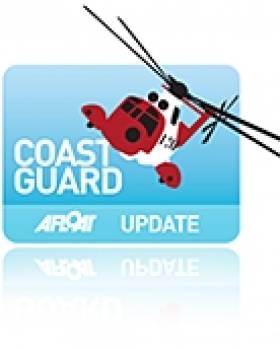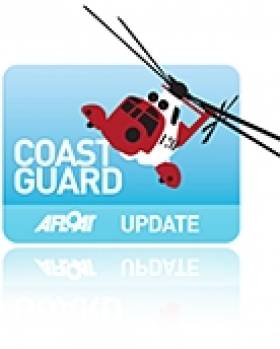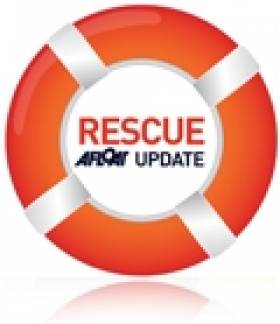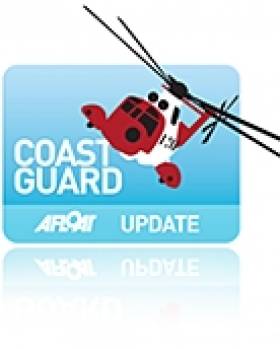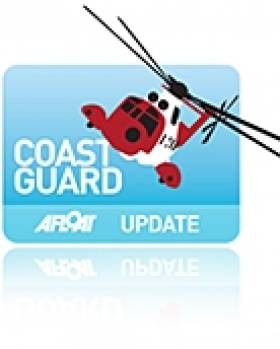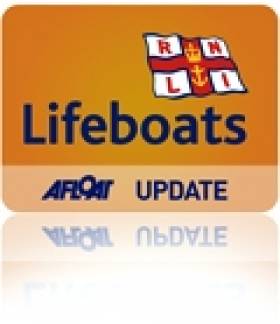Displaying items by tag: Coastguard
Overdue Sailor Located
He had last communicated with his brother yesterday morning when he departed Peel, Isle of Man on passage to Ardglass in Northern Ireland.
He had declared that he would call his brother on his arrival at 21.00 yesterday evening. He did not make that call and his brother alerted the authorities this morning.
Belfast Coastguard called out the Southdown and Bangor Coastguard rescue teams to undertake a search of harbours, marinas and anchorages. Other harbours and marinas are being checked around the Isle of Man and the Liverpool area.
At 02.37pm this afternoon, the Isle of Man authorities managed to get a fix on his mobile phone on one of the rare occasions that it was switched on which indicated that he was still in the area of the Isle of Man. The coordination of the incident was transferred to Liverpool Coastguard, who requested the launch of the Port Erin and Port St Mary RNLI lifeboats who eventually located him 6 miles west of Niarbyl, Isle of Man.
After they checked he was OK and determining what communications equipment he had, which in this case was a mobile phone that had gone flat and a hand held VHF radio that was turned down, the sailor was confident that he would continue his passage to Ardglass.
Su Daintith, Watch Manager, Liverpool Coastguard said:
We are pleased that this sailor has been located safe and well and hope that he learns from this sailing experience that good communications and knowing how to use them are a vital part of equipment on any sailing trip.
You can always register your vessel with our small yacht and boat safety scheme CG66 and we would advise sailors that they can always let us know their passage plan.
Reprieve for Holyhead Coastguard a 'Victory for People Power'
A former mayor of Holyhead has sung the praises of Holyhead's coastguard station to Afloat.ie.
Commenting on our recent report on plans to close Liverpool's coastguard station, Cllr KR Roberts said it was "a victory for people power" that Holyhead in north Wales joins Bangor in Northern Ireland among those stations reprieved under revised proposals for the streamlining of Britain's coastguard network.
"Holyhead Coastguard covers a vast area of the Irish Sea in close proximity to the Irish coast, where it joins forces with their Irish Coast Guard colleagues to provide a service of maritime safety to both commercial vessels and leisure craft alike," said Cllr Roberts.
"Holyhead Coastguard also provide maritime safety cover to over 300 miles of Welsh coastline that welcomes a vast variety of leisure craft from Ireland.
"As a past mayor and local councillor in Holyhead I am proud to promote the long traditions of maritime connections between Wales and Ireland. However I am sorry to see the loss of any coastguard station - in this case Liverpool Coastguard, which provides maritime safety cover to the northwest coast of England and the Scottish borders around the Solway Firth."
Cllr Roberts added that these areas would be taken over by Holyhead "with resilient support from Belfast and Milford Haven Coastguards".
Those participating are asked to assemble at the Hibernia Inn (near Bray Dart Station) from 13.00 hours. At 14.00 hours, an anchor shaped wreath will lead the procession of wreaths to the north Bray pier-head where a memorial service will be held, at which representatives of those in attendance will be invited to speak.
This will be followed by one minute's silence after which, those accompanying the wreaths will embark on the flotilla to a position approximately five-cables due east of Bray Harbour.
Anyone who would like to assist in the preparations and to remember those who have been lost are invited to attend. For further information, contact Tony O'Grady, Captain, (retired) on behalf of "Mariners with Memories" on Tel: (01) 276 0575 Mob: 087 245 4071 Email: [email protected] in addition to this LINK.
Concerns Over Belfast Coastguard Jobs
Concerns persist over the future for Northern Ireland’s coastguard service staff - despite the British government backing down from plans to close the Bangor search and rescue centre.
As previously reported on Afloat.ie, the Bregenz House station was given a reprieve under revised proposals to streamline the UK's coastguard network.
However the coastguard workers' union told the Belfast Telegraph that assurances must still be given to preserve "the same level of service”.
Ian Graham of the Public and Commercial Services (PCS) union said: "The numbers they’re quoting in the proposals are not providing this service with enough staff.
"Lives are still at risk with these proposals, there isn’t one UK coastguard I have spoken to that doesn’t disagree with that. We need to keep fighting to safeguard the service. This was a small victory.”
The Belfast Telegraph has more on the story HERE.
Bangor's Future 'A Victory for People Power'
The decision to keep open Northern Ireland's only dedicated search and rescue base is a victory for people power, says the Belfast Telegraph.
As previously reported on Afloat.ie, the station at Bangor was saved from closure following a review of plans to streamline the UK's coastguard network.
In an editorial on Friday, the paper said: "Northern Ireland really is a place apart geographically and no-one was convinced that the waters around our coastline from Lough Foyle to Strangford and the inland waterways of Lough Neagh and Lough Erne could be safely monitored by what amounted to remote control if Belfast Coastguard was closed."
The preservation of the service at Bangor is also "a victory for common sense".
The paper added: "From now on every person plucked from the sea or the loughs will utter a heartfelt thanks to those who fought to keep the service locally-based and they will also praise Transport Minister Phillip Hammond for sparing it from closure."
Children Rescued From Co Down Waters
Four teenagers were rescued in Co Down last weekend when they were cut off by the tide, the News Letter reports.
The teens were caught up to their shoulders in water at Ardilea on Saturday evening when they were retrieved by a former volunteer coastguard who lives nearby.
The group were met at the shore by the South Down Coastguard Rescue Team and NI Ambulance Service paramedics and taken to hospital showing signs of hypothermia.
Meanwhile, on Friday night RNLI Bangor lifeboat rescued a young girl stranded on a rock near Groomsport after a call from a member of the public.
“With waves breaking around the knees of the frightened child it was paramount that she be brought ashore as quickly as possible," said a coastguard statement.
The girl was treated by waiting paramedics at the shore.
Bangor Coastguard Centre Saved from the Chop
Northern Ireland's only dedicated search and rescue command centre has been saved from closure following a review of plans to streamline the UK's coastguard network.
BBC News reports that UK Transport Minister Phillip Hammond told the House of Commons today that the coastguard station at Bangor would remain open and operate 24 hours a day, allaying concerns that the station would be reduced to daytime-only service.
"Had this decision gone the wrong way, it would not simply have been a blow for the staff here in Bangor, but for all of Northern Ireland," commented North Down MLA Peter Weir.
The Bangor station will be one of eight full-time centres across the UK that remain open, while the stations at Clyde, Forth, Portland and Liverpool will be closed.
BBC News has more on the story HERE.
Four Teenagers Rescued in Dundrum Bay
Belfast Coastguard immediately tasked Southdown Coastguard Rescue Team and requested the launch of the Newcastle RNLI Inshore Lifeboat. Northern Ireland Ambulance Service also responded to the incident.
Whilst search and rescue units were proceeding to the incident, a gentleman who has formally served as a volunteer Coastguard and lives nearby assisted in the rescue. He managed to get his dinghy into the water and get to the teenagers who were showing signs of hypothermia and were complaining of the cold.
After recovering all four teenagers with his dinghy, he made shore to be met by members of Southdown Coastguard Rescue Team and NI Ambulance Service paramedics. The four were transported to hospital by two ambulances for further assessment.
Gary Young, Watch manager, Belfast Coastguard said:
These teenagers are extremely lucky to have been rescued this evening. I would like to pay tribute to the quick thinking of a former Coastguard who's actions certainly made for a happy ending to this potentially life threatening incident. Southdown CRT also showed their professionalism throughout this incident which was co-ordinated by MRCC Belfast.
We would like to remind anyone visiting the coast to take great care near water. Do not put yourselves at risk and if you find yourselves in trouble, dial 999 and ask for the Coastguard.
Search and rescue operations from Northern Ireland's only dedicated coastguard centre are on the increase, the Belfast Telegraph reports.
The latest figures show that there were 50 per cent more callouts to the Bangor-based centre last year than in 2006.
Shipping Minister Mike Penning - who is behind controversial plans to streamline the UK's coastguard network, which could see Bangor either closed or reduced to daylight operation - also confirmed that more than a third of callouts were made at night.
As previously reported on Afloat.ie, the final decision on the coastguard proposals will be taken by 19 July.
On Saturday July 2, Lough Derg RNLI Lifeboat launched, following a request by Valentia Coast Guard, to assist two persons on board a 22ft motor cruiser, that had suffered engine failure and was drifting close to rocks on the Urra shore. The Lifeboat with helm Eleanor Hooker, Ger Egan and Dom Sharkey on board, launched at 19.30hrs. Winds were southwesterly, Force 2. The lifeboat arrived on scene 19.35hrs. The two persons were safe and unharmed and both wearing life-jackets. The vessel was taken under tow, and tied safety alongside at the public harbour at Dromineer at 19.55hrs. The skipper of the vessel thanked the lifeboat crew and said that when he 'saw smoke coming from the engine, he had no option but to cut the power and call for help". He was reassured by the crew that he had done the right thing. The lifeboat returned to station and was ready for service again at 20.20hrs.
At 17.23hrs on Friday July 1, Lough Derg RNLI Lifeboat was requested to launch by Valentia Coast Guard, to assist two persons in difficulty in the water, after their jet ski failed close by the Scilly Islands, at the south-western end of Lough Derg. The Lifeboat with helm Peter Clarke, Eleanor Hooker and Ger Egan on board, launched at 17.35hrs. Soon after launching, the lifeboat was informed that a lakeboat was also going to the assistance of the persons in the water. The lifeboat arrived on scene 17.55hrs. The crew spoke to fishermen in the only lakeboat in the vicinity. The fishermen had no English but conveyed to the crew that they had taken the jet ski and the persons to a landing place on the Tipperary shore. Lifeboat crew searched the Tipperary shoreline indicated by the fishermen, including private harbours, but were unable to locate the jet-skiers or their jet-ski. The Coast Guard were unable to make contact with the person who had called in the request for help. The lifeoboat was stood down at 18.10hrs. The lifeboat returned to station and was ready for service again at 18.40hrs

























